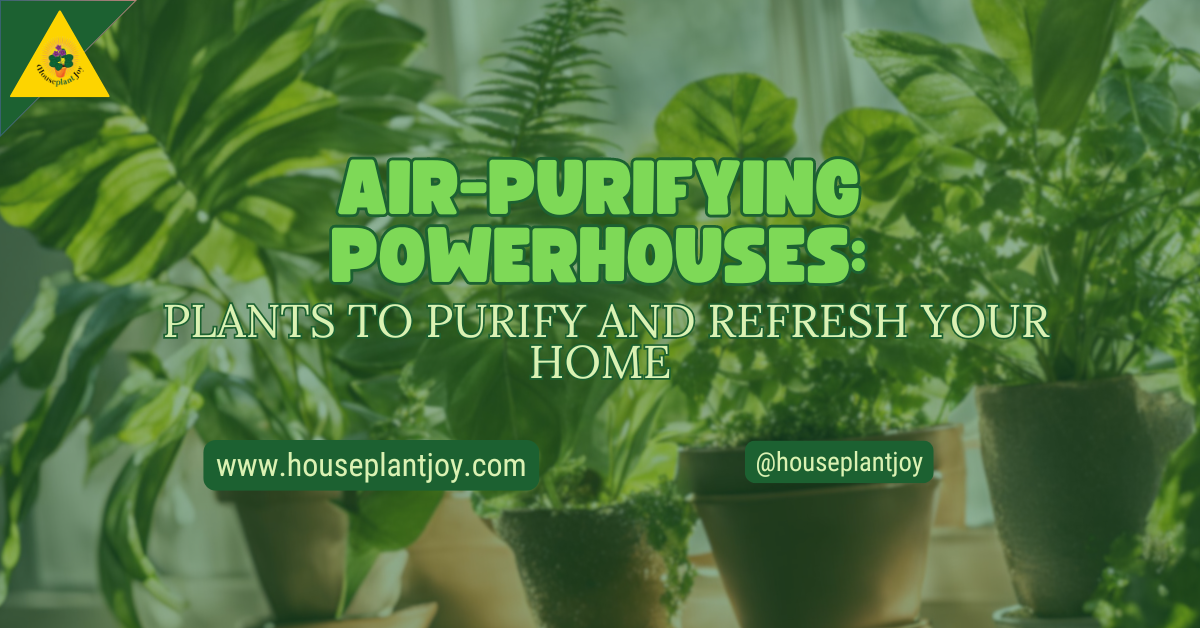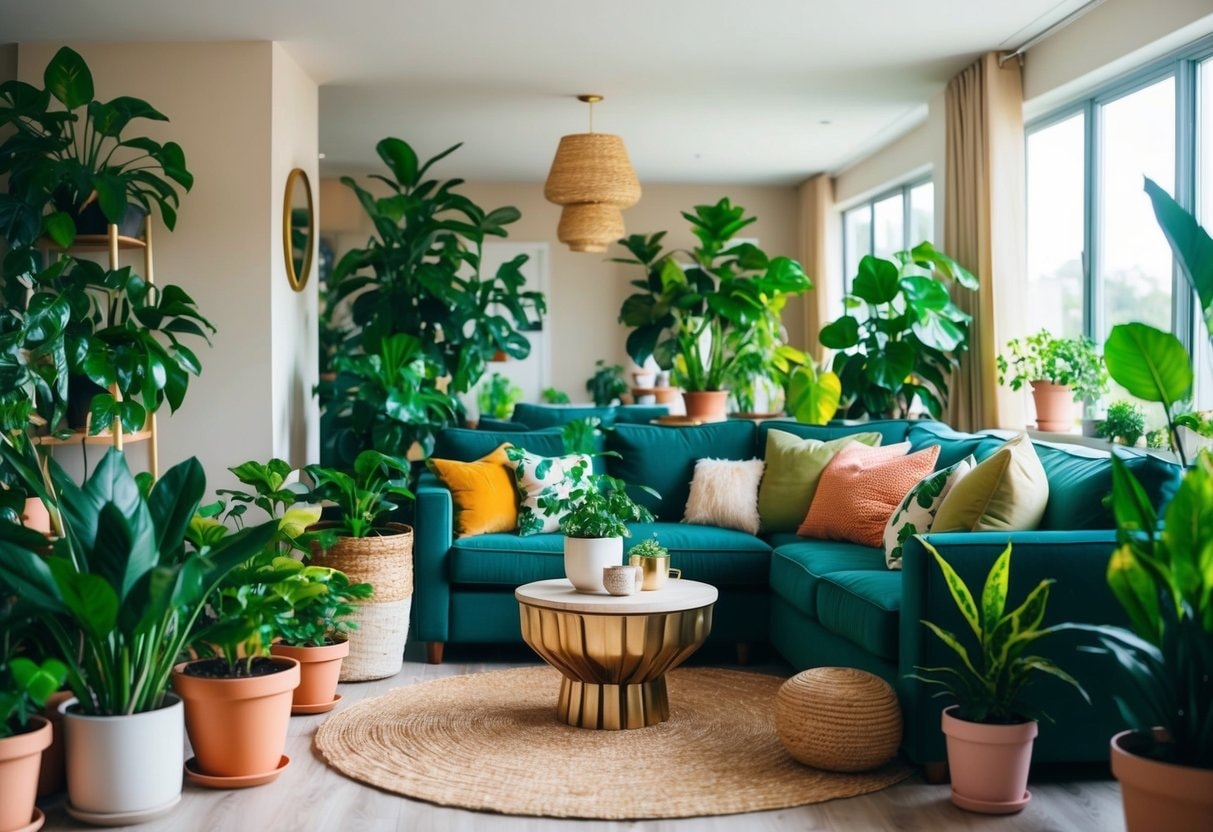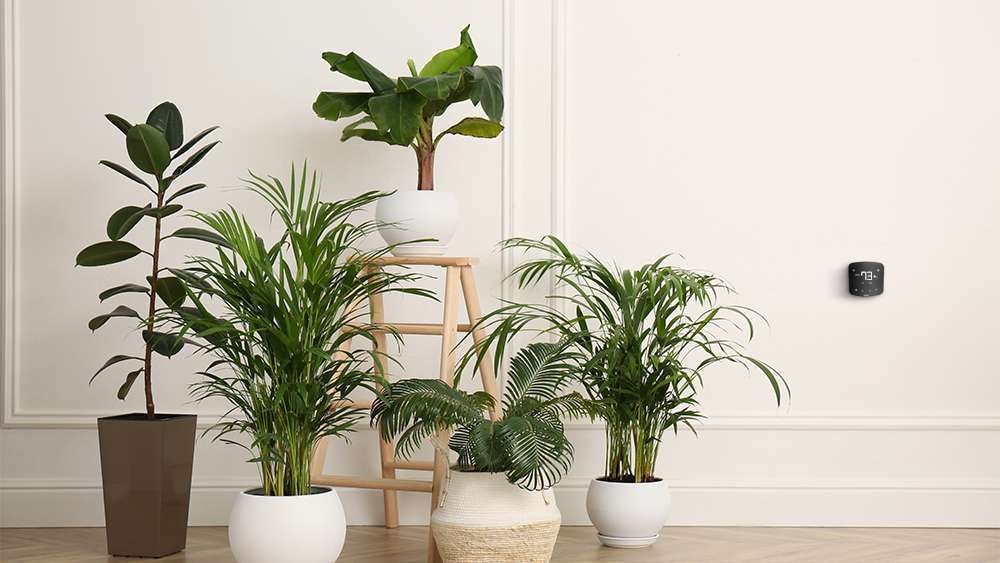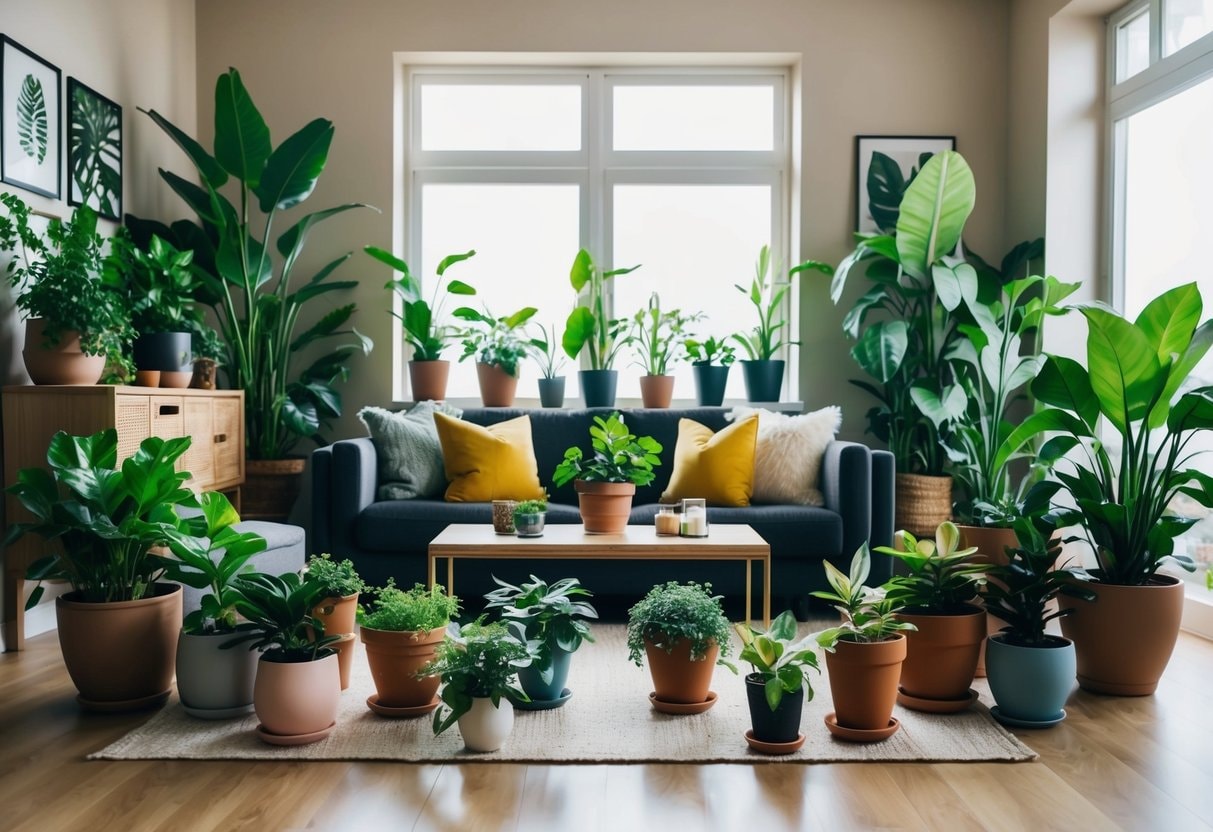HousePlantJoy is supported by our audience. When you purchase through one of our links, we may earn a small affiliate commission. As an Amazon Associate I earn from qualifying purchases. Your cost is not affected.
==================
Creating a serene and healthy home environment is more important than ever in today’s fast-paced world, and air-purifying powerhouses like these plants can help achieve that. Enter air-purifying plants—nature’s little superheroes that beautify your space and work tirelessly to cleanse the air you breathe. These plants come in various forms, from lush ferns to vibrant snake plants, each possessing unique abilities to filter out toxins and improve air quality. Scientific studies have shown that indoor plants can effectively remove harmful pollutants like formaldehyde and benzene while boosting humidity levels, alleviating respiratory issues, and enhancing overall comfort. Incorporating these plants into your living space allows you to enjoy cleaner air while adding a touch of nature to your home decor.
But with so many options available, how do you choose the right plants for your home? Not all air-purifying plants are created equal, and factors like light conditions, humidity levels, and your style will influence your choices. This article delves into the incredible benefits of air-purifying powerhouses, providing insights into the best environmental varieties. Whether you’re a seasoned plant enthusiast or a novice looking to bring greenery into your home, you’ll find valuable tips to help you refresh your living space and improve indoor air quality. Prepare to transform your home into a vibrant oasis of health and tranquility!
Air-Purifying Powerhouses: Greenery to Cleanse and Refresh Your Home – Nature’s Fresh Air Factories for Your Living Space
Breathe easier and freshen up your living space with air-purifying powerhouses—plants that are as functional as they are beautiful. These green friends not only enhance the aesthetic of your home but also work hard to clean the air you breathe. Air-purifying powerhouses can remove harmful toxins from indoor air, making your home healthier and more pleasant.
Want to improve your home’s air quality naturally? Air-purifying houseplants are the answer. They absorb pollutants through their leaves and roots, turning them into food for growth. This process cleans your air and boosts oxygen levels, creating a fresher environment.
Adding these plants to your home is easy and fun. You can place them in any room to enjoy cleaner air and a touch of nature. From small succulents to large leafy plants, there’s an air-purifying option for every space and style.
Key Takeaways
- Air-purifying plants improve air quality by removing harmful toxins like formaldehyde and benzene while increasing oxygen levels and boosting humidity.
- Different plants suit different environments, some thriving in low light and others requiring more sunlight. Choose plants based on your home’s light and humidity conditions.
- Top air-purifying plants include snake plants, peace lilies, and spider plants, which cleanse the air and add natural beauty to your space.
- Proper care enhances air-purifying efficiency, so water and place your plants according to their specific needs for optimal results.
The Essentials of Air-Purifying Plants
Air-purifying powerhouses, such as air-purifying plants, can help clean the air in your home. These green friends remove toxins and add fresh oxygen to your space. NASA has studied plants that clean the air and found that some air-purifying powerhouses are better at this job than others.
Peace lilies are star performers. They can remove up to 25% of airborne toxins in just one day. They’re especially good at getting rid of benzene. Another top pick is the rubber plant. Its big, shiny leaves look great and work hard to clean your air. They’re good at removing formaldehyde.
These plants don’t just clean your air. They also make your home look more lively and green. When choosing air-purifying plants, think about where you’ll put them. Some like bright light, while others do well in shade.
Remember to care for your new plant friends. Water them when needed and give them the right amount of light. With a bit of love, they’ll keep your air fresh for years.
Spider Plant: Nature’s Air Cleaner
Spider plants are easy to grow and great at cleaning air. They remove harmful chemicals like formaldehyde and xylene. These plants grow quickly and make “babies” you can share with friends.
Spider plants like bright, indirect light. Water them when the soil feels dry. They’re safe for pets, too. To boost air cleaning, place spider plants in bedrooms or living areas. Hang them in baskets for a relaxed look. Their long leaves will dangle down and purify your air.
Snake Plant: Oxygen Factory
Snake plants are tough and produce lots of oxygen. They work even at night, making them perfect for bedrooms. These plants remove toxins like benzene and trichloroethylene from the air.
You don’t need a green thumb for snake plants. They grow in low light and need little water. Choose a spot and let them do their thing. Snake plants have tall, sword-like leaves. They come in different colors and patterns. Pick one that fits your style, and watch it clean your air.
Peace Lily: Beauty and Purification
Peace lilies are pretty and powerful air cleaners. They remove many toxins, including benzene and ammonia. Their white flowers add beauty to any room. These plants like low to medium light. Water them when the soil feels dry.
Be careful with pets, as peace lilies can be toxic if eaten. Place peace lilies in bathrooms or kitchens. They help remove mold spores from the air. Their glossy leaves also add a touch of elegance to your space.
Rubber Plant: Low-Light Purifier
Rubber plants are great for cleaning indoor air. They remove formaldehyde and other toxins. These plants can grow tall, making a significant impact on your home. You can grow rubber plants in low-light areas. Water them when the top inch of soil is dry.
Wipe their big leaves to keep them shiny and healthy. Rubber plants come in green or burgundy colors. Put them in corners or as focal points in rooms. They’ll clean your air while adding a touch of nature to your decor.
Did You Know?
Some low-maintenance plants are excellent for purifying the air. Snake plants, for example, require minimal water and can thrive in low light. Pothos is another easy-care plant known for its air-purifying qualities. Spider plants are simple to grow, needing only indirect light and moderate watering. Aloe vera is also a low-fuss option that effectively cleanses the air.
Watering Your Green Allies
Don’t let your plants get too thirsty or too wet. Check the soil moisture before watering. Stick your finger about an inch into the soil. If it feels dry, it’s time to water. Different plants have different needs.
Spider plants and pothos like to dry out between waterings. Peace lilies prefer consistently moist soil. Water deeply until it runs out the bottom of the pot. Empty the saucer so the roots don’t sit in water. In winter, most plants need less water.
The Right Light for Thriving Plants
Light needs vary by plant type. Boston ferns love bright, indirect light. Snake plants can handle low-light areas. Plants should be placed near windows but avoid direct sunlight, which can burn leaves. Rotate pots weekly for even growth.
If leaves turn yellow, your plant may need more light. For darker spaces, try low-light tolerant plants like pothos or snake plants. You can also use grow lights to supplement natural light.
Soil and Fertilizer: Foundations of Health
Use a well-draining potting mix for most indoor plants. This prevents root rot and helps air flow to roots. Repot your plants every 1-2 years with fresh soil. This gives roots more space and refreshes nutrients.
Feed your plants during the growing season (spring and summer). Use a balanced, water-soluble fertilizer monthly. Follow package instructions for amounts. Don’t overfertilize. This can harm plants and reduce their air-cleaning power. In fall and winter, most plants need little to no fertilizer.
The Science Behind Plants and Air Purification
Plants do more than just look pretty in your home; they are air-purifying powerhouses that can clean the air you breathe! This amazing ability comes from how plants grow and live. When plants make food, they take in carbon dioxide and give out oxygen. This process is called photosynthesis. It’s like the plant is breathing in reverse from you!
But that’s not all. Plants can also suck up other stuff from the air. They pull in gases and tiny bits of dirt through tiny holes in their leaves. These holes are called stomata. The dirt and gases don’t stay in the leaves. They move down into the soil, where the plant’s roots are. Tiny living things in the soil break down these harmful bits.
NASA found out that plants can clean indoor air really well. They tested this for space stations. But it works great in homes, too! Some plants are better at cleaning air than others. The snake plant is a champ at this job. It even makes oxygen at night, which is rare for plants.
You might think outdoor air is dirtier than indoor air. But indoor air can be up to 30 times more toxic! That’s why having air-cleaning plants in your home is so great. So next time you look at your houseplants, remember they’re not just sitting there. They’re hard at work making your air cleaner!
Designing Your Space with Purifying Plants
Adding air-purifying plants to your home can improve air quality and create a fresh, vibrant atmosphere. Incorporating air-purifying powerhouses into your space is essential, as the right placement and arrangement can maximize both health benefits and visual appeal.
Arranging Plants for Aesthetic and Health Benefits
Mix different plant sizes and shapes to create visual interest. Place tall plants like rubber trees in corners or behind furniture. Use medium-sized plants on shelves or side tables. Set small plants on desks or countertops.
Group plants with similar care needs together. This makes watering and maintenance easier. Create a focal point with a striking plant like a peace lily. Surround it with smaller plants for a layered look. Use decorative pots to complement your decor. Choose materials like ceramic, wood, or woven baskets. Make sure pots have drainage holes to prevent overwatering.
Plants in Different Rooms: Strategic Placement
In the bedroom, try calming plants like lavender or snake plants. These can help you relax and improve sleep quality. Put them on nightstands or dressers. For bathrooms, pick plants that thrive in humid conditions. Ferns and spider plants work well here. They can help reduce moisture and fight mold growth.
In the kitchen, use herbs like basil or mint. They purify the air and provide fresh ingredients for cooking. Place them on windowsills or countertops. Try larger plants like fiddle leaf figs or rubber plants for living rooms. These make bold statements and clean air effectively. Put them near seating areas or in bright corners.
Combating Common Indoor Air Pollutants
Your home can be full of hidden air pollutants. But don’t worry!
There are easy ways to fight back and keep your air clean with air-purifying powerhouses.
- First, tackle dust and pet dander. Vacuum often with a HEPA filter vacuum. Dust surfaces regularly with a damp cloth to trap particles.
- Next, watch out for volatile organic compounds (VOCs). These come from things like paint, cleaning products, and new furniture. Pick low-VOC options when you can. Open windows for fresh air to help clear out these chemicals.
- Mold is another sneaky pollutant. Keep humidity between 30-50% to stop mold growth. Use dehumidifiers in damp areas like basements. Don’t forget about carbon monoxide. Install detectors and have your heating system checked yearly.
Plants and Mental Well-being: A Breath of Fresh Air
Having air-purifying powerhouses in your home can do wonders for your mental health. They bring a touch of nature indoors, creating a calming atmosphere that helps reduce stress and anxiety.
When you surround yourself with greenery, you’ll notice a boost in your mood. The simple act of caring for plants can be therapeutic, giving you a sense of purpose and accomplishment. Plants can also help you focus better.
They improve air quality, which leads to clearer thinking and increased productivity. You might find it easier to concentrate on tasks when you have some leafy friends nearby. Some plants are perfect for promoting relaxation:
- Lavender: Known for its soothing scent
- Snake Plant: Easy to care for and great at purifying air
- Aloe Vera: Removes harmful toxins and adds a fresh look to your space.
Adding plants to your bedroom can improve your sleep quality, too. They release oxygen at night, creating a more restful environment. Don’t worry if you’re not a green thumb. Many air-purifying plants are low-maintenance.
You can enjoy their benefits without much fuss. Remember, even a small potted plant on your desk can make a big difference. It’s a simple way to bring joy and peace to your daily life.
Take a look at this video on 11 houseplants that can boost your mental health.
Air-Purifying Powerhouses: Greenery to Cleanse and Refresh Your Home
Incorporating air-purifying powerhouses into your home offers more than just aesthetic appeal; it contributes significantly to creating a healthier living environment. These plants filter harmful toxins from the air and introduce a sense of tranquility and natural beauty into your space. By selecting the right plants, such as snake plants, peace lilies, and spider plants, you can ensure that your home remains a fresh, vibrant oasis that promotes physical and mental health. Caring for these green allies requires minimal effort, making them an ideal addition to any room in your house.
As you cultivate your collection of air-purifying powerhouses, you’ll also notice improvements in indoor air quality and overall ambiance. These plants serve as natural detoxifiers, reducing pollutants like formaldehyde and benzene while adding a refreshing burst of oxygen. Whether enhancing a cozy corner with a small succulent or making a bold statement with a tall rubber plant, these greenery choices will transform your home into a sanctuary of health and calm. Embrace the power of nature’s air-purifying wonders to cleanse, refresh, and rejuvenate your living space.
What Are the Top Recommended Plants for Improving Indoor Air Quality?
How Do Plants Help in Removing Toxins From Our Home Environments?
Which Plants Are Specifically Known for Their Ability to Purify Bathroom Air?
Are There Any Scientific Studies, Like NASA's, That Prove the Effectiveness of Plants in Purifying Air?
What Are the Benefits of Having Air Purifying Plants Outdoors?
Why Join Our Community?
Discover Exclusive Insights: Unlock valuable tips to help your plants flourish and bloom like never before.
Professional Guidance: Connect with our knowledgeable team on Facebook, Twitter, and other social media platforms. Our gardening experts are excited to assist you on your plant journey.
Connect with Fellow Enthusiasts: Engage with other plant aficionados, share your experiences, and cultivate a nurturing community. Join us today! Follow Houseplant Joy on Facebook, Instagram, and Twitter for daily motivation and a flourishing experience! #HouseplantJoy #GreenThumbsUnite #HouseplantLove








